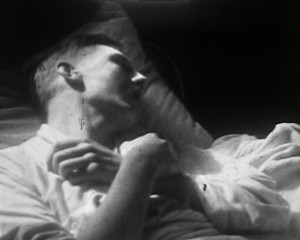
"Story of murder during a treasure hunt." Movie Makers, Nov. 1933, 475.
"Pipe Dreams, by Joseph Dephoure, ACL, and Edward Atkins, ACL, is ranked among the year's ten best because of its considerable triumphs over dramatic and technical difficulties. Through the imagination of its producers, a small cast, simple settings and moderate footage have been used to tell a big story, rich in pictorial effect. Dreaming that he has murdered his unfaithful wife, a young man sees in prospect the swift and fearful course of his life to the waiting gallows. The murder, the trial, the death cell and the hanging are represented in large part only by the imaginative and striking use of shadows of the real scenes. Occasional straight shots are heightened in effect by unusual angles and dramatic lighting. Sensitively planned, smartly executed and deftly cut, Pipe Dreams makes its simple story exciting and forceful." Movie Makers, Dec. 1933, 500.
"The story concerns a girl who, during her husband’s absence in the East, takes a lover. The husband returns home unexpectedly, and, in a heated scene, threatens the lover with an automatic. Unfortunately for him this expansive gesture is witnessed by a tramp. The tramp thinks he had better retreat. As he hurries from the scene he hears a shot ring out and returns to find that the lover has been killed. He reports to a policeman, with the result that the husband is arrested, tried, and condemned to death. Dramatic Climax - With feminine perversity the wife now realises that it is her husband who she really loves, and implores her sister’s fiancé, a member of the C.I.D., to save her husband, whom she believes innocent. He promises to do his best, and, on fuller investigation, finds a sodden letter near the spot where the murder was committed. On making enquiries he finds that a man has recently been lodging at the address given on the envelope, who had just returned from America, and had disappeared on the day of the murder. When finally arrested the man tells of a private vendetta with the lover and of his determination to be avenged. A witness to the quarrel, he shoots the erstwhile friend just after the quarrel with the husband. The final scenes lend themselves to a thrilling climax. The final shot portrays the face of the murderer as he discharges his gun point blank at the audience" (M.A.L.B. 1931: 6).
"'Ritual of the Dead,' is an old-fashioned thriller. The leading characters, that of the young man who murders rather promiscuously and the tattered mummy who returns to life seemingly to accuse the murderer after the latter has reason to believe he has safely escaped detection for his crimes are carried by the producer. The denouement of the story, which is just that we have here intimated, carries a real thrill" American Cinematographer, Jan. 1939, 16-17.
"this is not just another murder mystery, but a drama of a battle of wits between two men" (HMHT 1933: 448).

Un pequeño niño llamado Sergio hace una lista de regalos que desea, en la que incluye un traje de soldado, una metralleta y otras armas. Después Sergio tiene un sueño en el que es un soldado explorando el campo y divirtiéndose con sus armas; el sueño se transforma en pesadilla cuando ve a su familia muerta y cubierta de sangre. Sergio llora y besa a sus familiares muertos para después tirar su metralleta de juguete cubierta de sangre. Después despierta asustado y destruye su lista de deseos.
A little boy named Sergio makes a wish list of gifts that include a soldier suit, a machine gun and other weapons. He then has a dream of himself as a soldier exploring the country and having fun with his guns; the dream turns into a nightmare when he sees his family dead and covered in blood. He cries and kisses the dead members of his family and finally he throws away his toy machine gun covered in blood. Sergio wakes up scared and destroys his wish list.
"All the title implies-death does bring silence to the dead, and in this instance peace and quiet for the survivor. The man is disturbed, his nerves are frayed with a noise beyond his endurance and he decides the end is the cure. The Orange County Cinema Club has turned a neat little trick with this film" PSA Journal, Nov. 1958, 46.

‘Ayako prays at the grave of her brother. Returning home, she helps Seizo - her late brother's young friend - to release his kite caught in the trees; an interlude that restores memories of the departed. Rural life and customs and the special delights of childhood are skilfully conveyed’ (EAFA Database).
Referred to "Sister and Brother" in 1932 American Cinematographer competition.

"Amateur filmmaker, cinema historian and railway engineer H.A.V. Bulleid presents a tale of paternal foreboding and rural tragedy. When a man dies, his widow seeks a suitable replacement to care for her and their son. Torn between two rival suitors - Dr. Vincent Moire and the mysterious Richard Grafton - the mother is unable to make a decision, despite her son expressing a clear preference for the doctor. When he is called away to town, Grafton seizes his opportunity and, wanting rid of the boy so that he might live with the mother in peace, shoves him over a cliff to his death. But when Grafton returns to the village, he spots the doctor - who has made an unexpected return - walking arm in arm with the widow. Distraught and defeated, Grafton claws at his neck and face in desperation, reaches into his jacket, pulls out a gun and kills himself." (EAFA Database)

Amateur film club production that parodies Russian tragedy literature. The story revolves around two warring families, the Yagustynkas and the Chenstohovas, a romance, a religious curse, and murder. Exaggerated intertitles contribute to the film's "burlesque" of Russian culture and literature.
Total Pages: 5